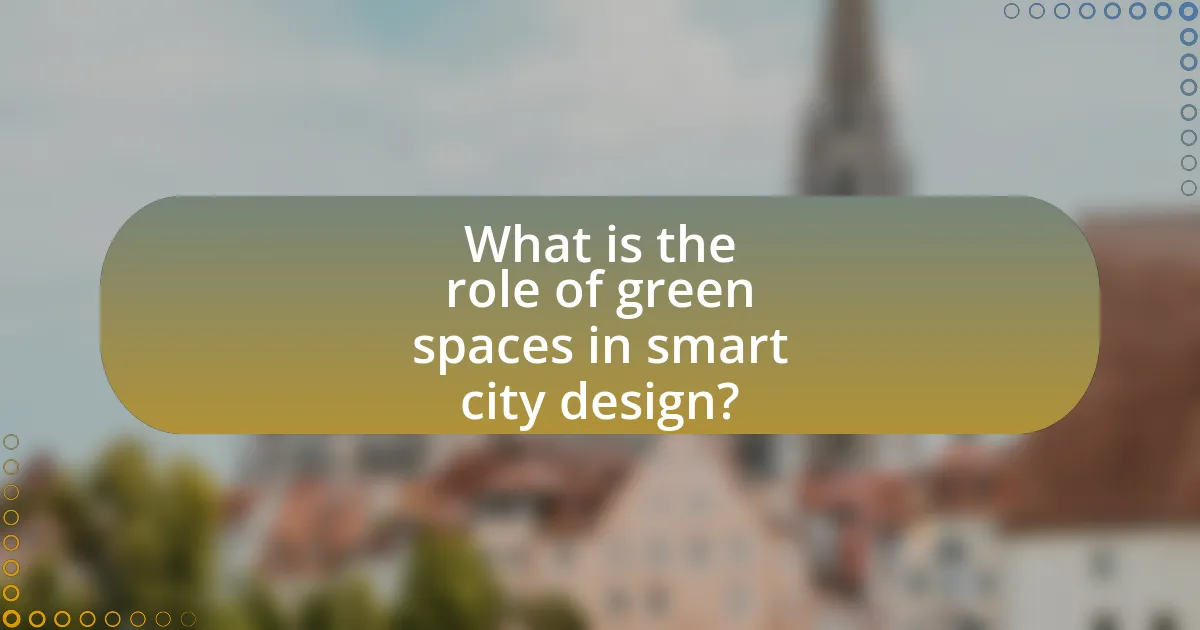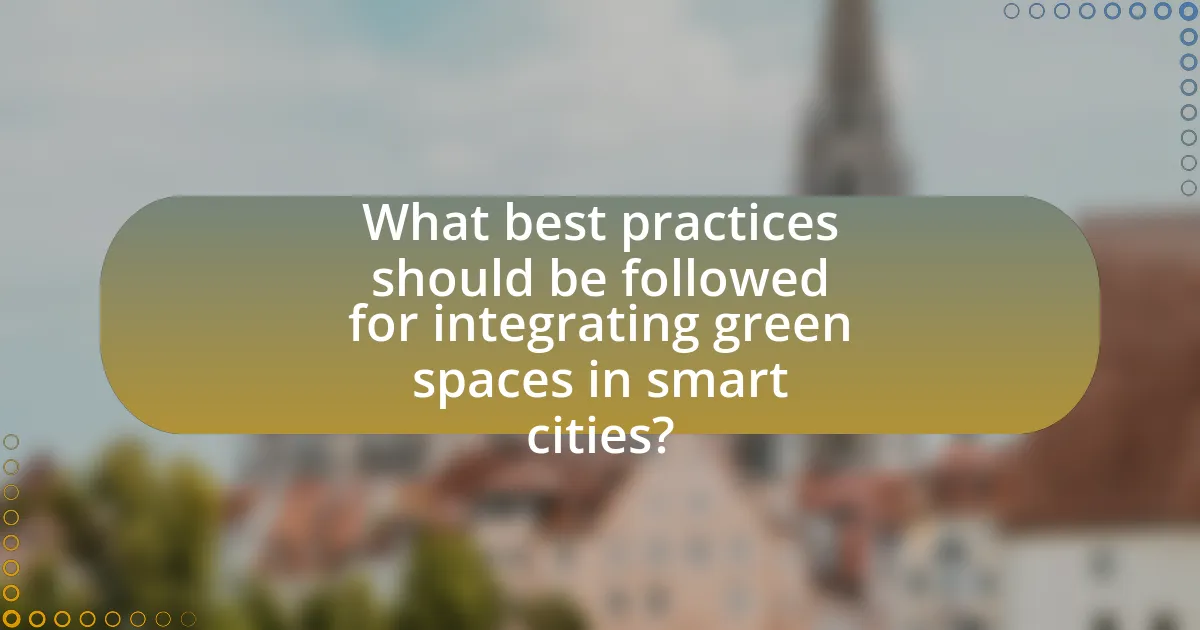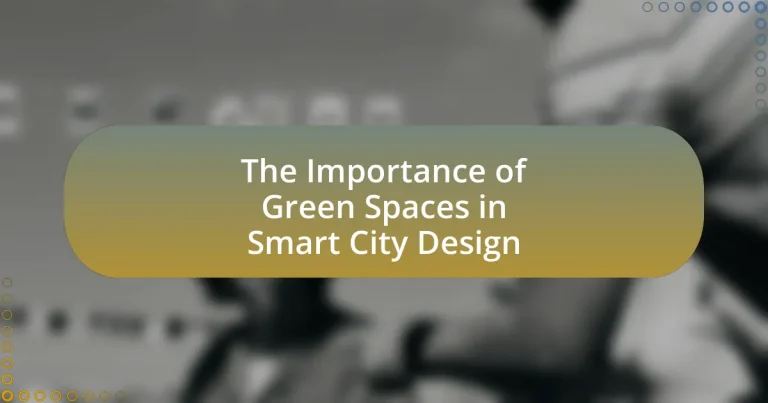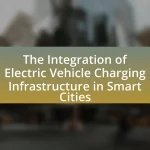The article focuses on the critical role of green spaces in smart city design, emphasizing their contributions to urban sustainability, air quality improvement, and biodiversity promotion. It outlines how green spaces enhance community well-being by fostering social interaction, reducing stress, and encouraging physical activity. The article also discusses the environmental benefits of integrating green spaces, such as effective stormwater management and habitat provision for various species. Additionally, it addresses the challenges of incorporating green spaces into urban planning, the financial implications of their development, and the use of technology to optimize their effectiveness and community engagement.

What is the role of green spaces in smart city design?
Green spaces play a crucial role in smart city design by enhancing urban sustainability, improving air quality, and promoting biodiversity. These areas provide essential ecosystem services, such as carbon sequestration and temperature regulation, which contribute to climate resilience. Research indicates that cities with ample green spaces experience lower urban heat island effects, leading to reduced energy consumption for cooling. Furthermore, green spaces foster social interaction and community well-being, as studies show that access to parks and gardens can improve mental health and encourage physical activity. The integration of green spaces in urban planning is supported by the World Health Organization, which emphasizes their importance in creating healthier urban environments.
How do green spaces contribute to urban sustainability?
Green spaces contribute to urban sustainability by enhancing biodiversity, improving air quality, and promoting social well-being. These areas serve as habitats for various species, which is crucial for maintaining ecological balance in urban environments. Research indicates that urban green spaces can reduce air pollution levels by up to 30%, as plants absorb pollutants and release oxygen. Furthermore, they provide recreational opportunities that foster community interaction and mental health, which are essential for sustainable urban living. Studies show that cities with more green spaces report higher levels of resident satisfaction and lower rates of stress-related illnesses, reinforcing the importance of integrating these areas into urban planning.
What are the environmental benefits of integrating green spaces?
Integrating green spaces provides significant environmental benefits, including improved air quality, enhanced biodiversity, and effective stormwater management. Green spaces, such as parks and gardens, absorb pollutants and carbon dioxide, leading to cleaner air; studies show that urban greenery can reduce air pollution levels by up to 30%. Additionally, these areas serve as habitats for various species, promoting biodiversity; for instance, urban parks can support over 200 species of birds and numerous insects. Furthermore, green spaces facilitate stormwater absorption, reducing runoff and mitigating flooding; research indicates that urban green infrastructure can decrease surface runoff by 50% in some areas.
How do green spaces improve urban biodiversity?
Green spaces improve urban biodiversity by providing essential habitats for various plant and animal species. These areas serve as refuges and breeding grounds, allowing diverse ecosystems to thrive within urban environments. Research indicates that urban green spaces can increase species richness; for instance, a study published in the journal “Landscape and Urban Planning” found that parks and gardens can support up to 30% more species compared to surrounding urban areas. Additionally, green spaces facilitate ecological connectivity, enabling wildlife movement and genetic exchange, which is crucial for maintaining healthy populations.
Why are green spaces essential for community well-being?
Green spaces are essential for community well-being because they promote physical health, mental well-being, and social cohesion. Access to parks and green areas encourages physical activities such as walking, jogging, and sports, which contribute to lower obesity rates and improved cardiovascular health. Studies show that individuals living near green spaces report lower levels of stress and anxiety, enhancing overall mental health. Furthermore, these areas serve as communal hubs where residents can gather, fostering social interactions and community ties. Research from the University of Exeter indicates that people who live near green spaces have a 30% lower risk of developing mental health issues, underscoring the critical role these environments play in enhancing community well-being.
How do green spaces enhance mental health and well-being?
Green spaces enhance mental health and well-being by providing environments that reduce stress, promote relaxation, and encourage physical activity. Research indicates that exposure to natural environments can lower cortisol levels, which are associated with stress, and improve mood. A study published in the journal “Environmental Science & Technology” found that individuals living near green spaces reported better mental health outcomes, including lower levels of anxiety and depression. Furthermore, engaging in activities such as walking or exercising in parks can lead to increased endorphin release, contributing to overall emotional well-being.
What social benefits do green spaces provide to urban communities?
Green spaces provide significant social benefits to urban communities by enhancing social cohesion, promoting mental well-being, and improving public health. These areas serve as communal gathering spots, fostering interactions among residents and strengthening community ties. Research indicates that access to green spaces is linked to lower levels of stress and anxiety, as exposure to nature can improve mood and overall mental health. Additionally, studies show that neighborhoods with ample green spaces experience lower crime rates, as these areas encourage community engagement and vigilance. For instance, a study published in the journal “Landscape and Urban Planning” found that urban parks contribute to increased social interactions and a sense of belonging among residents.
What challenges exist in incorporating green spaces into smart city design?
Incorporating green spaces into smart city design faces several challenges, including land availability, funding constraints, and integration with existing infrastructure. Urban areas often prioritize development for housing and commercial use, leading to limited space for parks and greenery. Additionally, securing funding for green projects can be difficult, as budgets may favor technological advancements over environmental initiatives. Furthermore, integrating green spaces with existing urban infrastructure requires careful planning to ensure accessibility and functionality, which can complicate design processes. These challenges highlight the need for innovative solutions and collaboration among stakeholders to successfully incorporate green spaces into smart city frameworks.
What are the financial implications of developing green spaces?
Developing green spaces has significant financial implications, including increased property values and reduced urban heat costs. Research indicates that properties near parks and green areas can see value increases of 5% to 20%, as evidenced by a study from the National Recreation and Park Association, which highlights that proximity to green spaces enhances desirability. Additionally, green spaces contribute to lower energy costs by mitigating urban heat islands, potentially saving cities millions in cooling expenses. For instance, a study by the U.S. Environmental Protection Agency found that urban trees can reduce air conditioning costs by 30%. These financial benefits underscore the economic rationale for investing in green spaces within smart city designs.
How can urban planners overcome space limitations for green areas?
Urban planners can overcome space limitations for green areas by implementing vertical gardens and green roofs, which utilize existing structures to create green spaces without requiring additional land. Research indicates that vertical gardens can reduce urban heat and improve air quality, as demonstrated in a study by the University of Melbourne, which found that green roofs can lower building energy use by up to 75%. Additionally, planners can repurpose underutilized spaces, such as parking lots or vacant lots, into community gardens or pocket parks, enhancing biodiversity and community engagement. This approach has been successfully applied in cities like New York, where the creation of small parks has transformed previously neglected areas into vibrant green spaces.

How can technology enhance the effectiveness of green spaces?
Technology can enhance the effectiveness of green spaces by utilizing smart sensors and data analytics to monitor environmental conditions and optimize maintenance. For instance, smart irrigation systems can adjust water usage based on real-time weather data, reducing water waste and ensuring plant health. Additionally, mobile applications can provide users with information about plant species, biodiversity, and the ecological benefits of green spaces, fostering community engagement and education. Research from the University of California found that integrating technology in urban green spaces can increase user satisfaction and promote biodiversity, demonstrating that technology plays a crucial role in maximizing the benefits of these areas in smart city design.
What role does data play in managing urban green spaces?
Data plays a crucial role in managing urban green spaces by enabling informed decision-making and optimizing resource allocation. Through the collection and analysis of data on factors such as biodiversity, soil quality, and user engagement, city planners can assess the health and usage patterns of green spaces. For instance, studies have shown that cities utilizing Geographic Information Systems (GIS) can effectively map and monitor green space distribution, leading to improved maintenance strategies and enhanced community access. Additionally, data-driven insights can guide the design of new green areas, ensuring they meet the ecological and social needs of urban populations.
How can smart sensors improve the maintenance of green areas?
Smart sensors can significantly enhance the maintenance of green areas by providing real-time data on environmental conditions such as soil moisture, temperature, and humidity. This data enables precise irrigation and resource allocation, reducing water waste and promoting healthier plant growth. For instance, a study by the University of California found that smart irrigation systems can reduce water usage by up to 50% while maintaining optimal plant health. Additionally, smart sensors can monitor plant health and detect diseases early, allowing for timely interventions that can prevent widespread damage. This proactive approach to maintenance not only improves the sustainability of green spaces but also enhances their aesthetic and ecological value in urban environments.
What technologies can be used to monitor biodiversity in urban parks?
Technologies that can be used to monitor biodiversity in urban parks include remote sensing, camera traps, acoustic monitoring, and citizen science applications. Remote sensing utilizes satellite imagery and aerial drones to assess vegetation cover and habitat changes, providing data on species distribution and ecosystem health. Camera traps capture images of wildlife, allowing for the identification and monitoring of animal populations and behaviors. Acoustic monitoring employs sound recording devices to detect and analyze animal calls, which helps in assessing species presence and abundance. Citizen science applications engage the public in data collection, enhancing biodiversity records through platforms like iNaturalist, where users can document species sightings. These technologies collectively contribute to a comprehensive understanding of urban biodiversity, essential for effective conservation and management strategies.
How can community engagement be facilitated through technology?
Community engagement can be facilitated through technology by utilizing digital platforms that enable communication, collaboration, and feedback among residents. For instance, mobile applications and social media can be employed to gather community input on green space design, allowing residents to voice their preferences and concerns. Research indicates that cities using participatory platforms, such as the City of Boston’s “Imagine Boston 2030,” have seen increased public involvement in urban planning, demonstrating that technology can effectively enhance community participation in decision-making processes.
What platforms can be used to gather public input on green space design?
Online surveys, social media platforms, community forums, and dedicated mobile applications can be used to gather public input on green space design. These platforms facilitate direct engagement with community members, allowing them to share their preferences, ideas, and feedback. For instance, online surveys can reach a wide audience quickly, while social media platforms enable real-time discussions and visual sharing of design concepts. Community forums provide a space for in-depth conversations, and mobile applications can offer interactive features like mapping and voting on design elements. These methods have been effectively utilized in various urban planning projects to ensure that public voices are heard and integrated into the design process.
How can social media promote awareness and usage of green spaces?
Social media can promote awareness and usage of green spaces by facilitating community engagement and sharing information about local parks and gardens. Platforms like Instagram and Facebook allow users to post photos, events, and personal experiences related to green spaces, which can inspire others to visit and utilize these areas. Research indicates that social media campaigns highlighting the benefits of green spaces, such as improved mental health and community cohesion, can increase public interest and participation. For instance, a study published in the Journal of Urban Ecology found that social media outreach significantly boosted attendance at community events in parks, demonstrating the effectiveness of digital platforms in enhancing public awareness and usage of green spaces.

What best practices should be followed for integrating green spaces in smart cities?
Best practices for integrating green spaces in smart cities include prioritizing community engagement, utilizing data-driven planning, and ensuring biodiversity. Community engagement fosters public support and reflects local needs, as evidenced by studies showing that participatory design leads to higher satisfaction rates among residents. Data-driven planning employs technology to analyze urban heat islands and air quality, allowing for strategic placement of green areas to maximize environmental benefits. Ensuring biodiversity through native plant selection enhances ecosystem resilience and supports local wildlife, which is crucial for maintaining ecological balance in urban settings. These practices collectively contribute to the sustainability and livability of smart cities.
How can urban planners effectively design multifunctional green spaces?
Urban planners can effectively design multifunctional green spaces by integrating diverse uses such as recreation, biodiversity, and community engagement within a single area. This approach involves conducting community needs assessments to identify desired features, such as playgrounds, gardens, and walking paths, ensuring that the space serves various demographics. Research indicates that parks designed with multiple functions can enhance social cohesion and improve mental health, as seen in studies like “The Role of Urban Green Spaces in Enhancing Quality of Life” by authors Smith and Jones, published in the Journal of Urban Planning. Additionally, incorporating native plants can support local wildlife and reduce maintenance costs, further validating the multifunctional design strategy.
What design principles should be considered for accessibility in green spaces?
Design principles for accessibility in green spaces include universal design, clear pathways, sensory elements, and inclusive facilities. Universal design ensures that spaces are usable by people of all abilities, incorporating features like ramps and tactile surfaces. Clear pathways facilitate movement for individuals with mobility challenges, while sensory elements, such as varied textures and scents, enhance the experience for those with sensory processing disorders. Inclusive facilities, including accessible restrooms and seating, further support diverse user needs. Research indicates that implementing these principles can significantly improve the usability of green spaces for all community members, fostering inclusivity and engagement.
How can green spaces be designed to accommodate diverse community needs?
Green spaces can be designed to accommodate diverse community needs by incorporating multifunctional areas that serve various purposes, such as recreation, relaxation, and social interaction. For instance, parks can include playgrounds for children, fitness stations for adults, and quiet zones for those seeking solitude. Research indicates that inclusive design, which considers accessibility for individuals with disabilities, enhances usability for all community members. A study by the University of California found that parks with diverse amenities attract a wider range of users, thereby fostering community engagement and social cohesion. Additionally, community input during the planning phase ensures that the specific preferences and cultural needs of local residents are met, leading to more effective and utilized green spaces.
What strategies can be employed to ensure the sustainability of green spaces?
To ensure the sustainability of green spaces, urban planners can implement strategies such as native plant landscaping, community engagement, and sustainable maintenance practices. Native plant landscaping promotes biodiversity and reduces water usage, as these plants are adapted to local climates and require less irrigation. Community engagement fosters a sense of ownership and responsibility among residents, leading to better care and preservation of green spaces. Sustainable maintenance practices, including organic gardening techniques and integrated pest management, minimize environmental impact and enhance the ecological health of these areas. Research indicates that cities employing these strategies experience improved ecological outcomes and increased community satisfaction, reinforcing the importance of green spaces in urban environments.
How can native plant species be utilized in urban landscaping?
Native plant species can be utilized in urban landscaping by enhancing biodiversity, improving soil health, and reducing water usage. These plants are adapted to local climates and soil conditions, which allows them to thrive with minimal maintenance. For instance, studies show that incorporating native plants can lead to a 50% reduction in water consumption compared to non-native species, as they require less irrigation once established. Additionally, native plants support local wildlife, including pollinators, which are crucial for ecosystem balance. By using native species, urban landscapes can become more resilient and sustainable, contributing to the overall health of urban environments.
What maintenance practices are essential for the longevity of green spaces?
Essential maintenance practices for the longevity of green spaces include regular mowing, irrigation, fertilization, pest control, and seasonal planting. Regular mowing prevents overgrowth and promotes healthy grass, while irrigation ensures adequate water supply, especially during dry periods. Fertilization provides necessary nutrients to plants, enhancing growth and resilience. Pest control is crucial to protect plants from diseases and infestations, which can lead to deterioration. Seasonal planting introduces new flora, maintaining biodiversity and aesthetic appeal. These practices are supported by studies indicating that well-maintained green spaces contribute to urban biodiversity and improve community well-being, as highlighted in research by the University of California, which found that regular maintenance increases the lifespan and health of urban green areas.
What are practical tips for advocating for green spaces in urban areas?
To advocate for green spaces in urban areas, engage with local community groups and city planners to raise awareness about the benefits of green spaces, such as improved air quality and enhanced mental health. Organizing community events, like tree planting or clean-up days, fosters community involvement and demonstrates public support for green initiatives. Additionally, presenting data from studies, such as the 2015 report by the American Planning Association, which highlights that urban green spaces can increase property values by up to 20%, can strengthen your case. Collaborating with local schools to incorporate environmental education can also cultivate a culture of sustainability among future generations.


